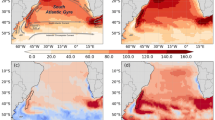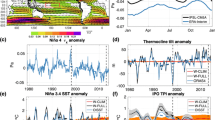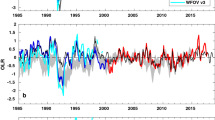Abstract
Using the Objectively Analyzed air–sea Fluxes dataset (and also the National Oceanography Centre Southampton Flux Dataset v2.0), we examined both the annual mean climatology and trend of net air–sea surface heat flux (Q net) for 1984–2004 over the North Pacific and North Atlantic oceans (10°N–50°N). The annual mean Q net climatology shows that oceans obtain the positive Q net over much of the North Pacific and North Atlantic oceans. Exceptions are the regions of western boundary currents (WBCs) including the Kuroshio and its extension off Japan and the Gulf Stream off the USA and its extension, where oceans release lots of heat into the atmosphere, mainly ascribed to the large surface turbulent heat loss. The statistically significant negative Q net trends occurred in the WBCs, while the statistically significant positive Q net trends appeared in the central basins of Northern Subtropical Oceans (CNSOs) including the central basin of Northern Subtropical Pacific and the central basin of Northern Subtropical Atlantic. These indentified Q net trends, which are independent of both El Niño-Southern Oscillation (ENSO) and ENSO Modoki but closely related to global warming forcing, are predominately due to the statistically significant surface latent heat (LH) trends. Over the WBCs, the positive LH trends are mainly induced by the sea surface temperature increasing, indicating the ocean forcing upon overlying atmosphere. In contrast, over the CNSOs, the negative LH trends are mainly caused by the near-surface air specific humidity increasing, indicative of an oceanic response to overlying atmospheric forcing.










Similar content being viewed by others
References
Alexander MA, Scott JD (1997) Surface flux variability over the North Pacific and North Atlantic Oceans. J Clim 10:2963–2978
An SI (2003) Conditional maximum covariance analysis and its application to the tropical Indian Ocean SST and surface wind stress anomalies. J Clim 16:2932–2938
Ashok K, Behera SK, Rao AS, Weng H, Yamagata T (2007) El Niño Modoki and its teleconnection. J Geophys Res 112:C11007. doi:10.1029/2006JC003798
Barnett TP, Pierce DW, AchutaRao KM, Gleckler PJ, Santer BD, Gregory JM, Washington WM (2005) Penetration of human-induced warming into the World’s Oceans. Science 309:284–287
Berry DI, Kent EC (2009) A new air–sea interaction gridded dataset from ICOADS with uncertainty estimates. Bull Amer Meteor Soc 90:645–656
Berry DI, Kent EC (2010) Air–sea fluxes from ICOADS: the construction of a new gridded dataset with uncertainty estimates. Int J Climatol doi:10.1002/joc.2059
Cayan DR (1992a) Variability of latent and sensible heat fluxes estimated using bulk formulae. Atmos Ocean 30:1–42
Cayan DR (1992b) Latent and sensible heat flux anomalies over the Northern Oceans: the connection to monthly atmospheric circulation. J Clim 5:354–369
Cayan DR (1992c) Latent and sensible heat flux anomalies over the Northern oceans: driving the sea surface temperature. J Phys Oceanogr 22:859–881
da Silva AM, Levitus S (1994) Anomalies of heat and momentum fluxes, vol. 3. Atlas of Surface Marine Data 1994, U.S. Department Commerce, p 413
Du Y, Xie SP (2008) Role of atmospheric adjustments in the tropical Indian Ocean warming during the 20th century in climate models. Geophys Res Lett 35:L08712. doi:10.1029/2008GL033631
Fairall CW, Bradley EF, Hare JE, Grachev AA, Edson JB (2003) Bulk parameterization on air–sea fluxes: updates and verification for the COARE algorithm. J Clim 16:571–591
Grodsky SA, Bentamy A, Carton JA, Carton RT (2009) Intraseasonal latent heat flux based on satellite observations. J Clim 22:4539–4556
Hansen J et al (2005) Earth’s energy imbalance: confirmation and implications. Science 308:1431–1435
Harries JE (1996) The greenhouse earth: a view from space. Quart J Roy Meteor Soc 122(532):799–818
Iwasaka N, Wallace JM (1995) Large scale air sea interaction in the Northern Hemisphere from a view point of variations of surface heat flux by SVD analysis. J Meteor Soc Japan 73:781–794
Joyce TM, Kwon YO, Yu L (2009) On the relationship between synoptic wintertime atmospheric variability and path shifts in the Gulf Stream and the Kuroshio extension. J Clim 22(12):3177–3192
Kiehl JT, Trenberth KE (1997) Earth’s annual global mean energy budget. Bull Amer Meteor Soc 78(2):197–208
Li G, Ren BH, Yang CY, Zheng JQ (2010a) Traditional El Niño and El Niño Modoki revisited: is El Niño Modoki linearly independent of traditional El Niño? Atmos Oceanic Sci Lett 3:70–74
Li G, Ren BH, Yang CY, Zheng JQ (2010b) Indices of El Niño and El Niño Modoki: an improved El Niño Modoki index. Adv Atmos Sci 27(5):1210–1220. doi:10.1007/s00376-010-9173-5
Li G, Ren BH, Zheng JQ, Wang J (2009) Characteristics of low-frequency oscillation intensity of air–sea turbulent heat fluxes over the northwest Pacific. Sci China Ser D-Earth Sci 52(8):1137–1151
Liu H, Pinker RT (2008) Radiative fluxes from satellites: focus on aerosols. J Geophys Res 113:D08208. doi:10.1029/2007JD008736
Liu J, Curry JA (2006) Variability of the tropical and subtropical ocean surface latent heat flux during 1989–2000. Geophys Res Lett 33:L05706. doi:10.1029/2005GL024809
Liu WT, Zhang A, Bishop JKB (1994) Evaporation and solar irradiance as regulators of sea surface temperature in annual and interannual change. J Geophys Res 99(C6):12623–12637
Liu ZY, Liu Y, Wang LX, Jacob R (2007) Seasonal and long-term atmospheric responses to reemerging North Pacific ocean variability: a combined dynamical and statistical assessment. J Clim 20(6):955–980
Mann ME, Emanuel K (2006) Atlantic hurricane trends linked to climate change. Eos Trans Amer Geophys Union 87:233–244
Mochizuki T, Awaji T (2008) Summertime evolution of decadal sea surface temperature anomalies in the midlatitude North Pacific. J Clim 21(7):1569–1588
Park S, Deser C, Alexander MA (2005) Estimation of the surface heat flux response to sea surface temperature anomalies over the global oceans. J Clim 18:4582–4599
Polyakov IV, Alexeev VA, Bhatt US, Polyakov EI, Zhang X (2010) North Atlantic warming: patterns of long-term trend and multidecadal variability. Clim Dyn 34:439–457
Qiu B, Chen S, Hacker P (2004) Synoptic-scale air–sea flux forcing in the western North Pacific: observations and their impact on SST and the mixed layer. J Phys Oceanogr 34:2148–2159
Santer BD, Wigley TML, Boyle JS, Gaffen DJ, Hnilo JJ, Nychka D, Parker DE, Taylor KE (2000) Statistical significance of trends and trend differences in layer-average atmospheric temperature time series. J Geophys Res 105:7337–7356
Tanimoto Y, Nakamura H, Kagimoto T, Yamane S (2003) An active role of extratropical sea surface temperature anomalies in determining anomalous turbulent heat flux. J Geophys Res 108(C10):3304. doi:10.1029/2002JC001750
Ting M, Kushnir Y, Seager R, Li C (2009) Forced and internal twentieth-century SST trends in the North Atlantic. J Clim 22:1469–1481
Tomita H, Kubota M (2005) Increase in turbulent heat flux during the 1990 s over the Kuroshio/Oyashio extension region. Geophys Res Lett 32:L09705. doi:10.1029/2004GL022075
Trenberth KE (1997) The definition of El Niño. Bull Amer Meteorol Soc 78(12):2771–2777
Trenberth KE, Shea DJ (2006) Atlantic hurricanes and natural variability in 2005. Geophys Res Lett 33:L12704. doi:10.1029/2006GL026894
Trenberth KE, Smith L (2009) Variations in the three-dimensional structure of the atmospheric circulation with different flavors of El Niño. J Clim 22:2978–2991
Watterson IG, Dix MR (1996) Influences on surface energy fluxes in simulated present and double CO2 climates. Clim Dyn 12(5):359–370
Weng H, Ashok K, Behera SK, Rao SA, Yamagata T (2007) Impacts of recent El Niño Modoki on dry/wet conditions in the Pacific rim during boreal summer. Clim Dyn 29:113–129
Weng H, Behera SK, Yamagata T (2009) Anomalous winter climate conditions in the Pacific rim during recent El Niño Modoki and El Niño events. Clim Dyn 32:663–674
Yu L (2007) Global variations in oceanic evaporation (1958–2005): the role of the changing wind speed. J Clim 20:5376–5390
Yu L, Weller RA (2007) Objectively analyzed air–sea heat fluxes for the global ice-free oceans (1981–2005). Bull Amer Meteor Soc 88:527–539
Yu L, Weller RA, Sun B (2004a) Improving latent and sensible heat flux estimates for the Atlantic Ocean (1988–1999) by a synthesis approach. J Clim 17:373–393
Yu L, Weller RA, Sun B (2004b) Mean and variability of the WHOI daily latent and sensible heat fluxes at in situ flux measurement sites in the Atlantic Ocean. J Clim 17:2096–2118
Yu L, Jin X, Weller RA (2006) Role of net surface heat flux in seasonal variations of sea surface temperature in the tropical Atlantic Ocean. J Clim 19:6153–6169
Yu L, Jin X, Weller RA (2007) Annual, seasonal, and interannual variability of air–sea heat fluxes in the Indian Ocean. J Clim 20:3190–3209
Yu L, Jin X, Weller RA (2008) Multidecade global flux datasets from the Objectively Analyzed air–sea Fluxes (OAFlux) Project: Latent and sensible heat fluxes, ocean evaporation, and related surface meteorological variables. Woods Hole Oceanographic Institution, OAFlux Project Tech Rep OA-2008-01, p 64
Zeng L, Wang D (2009) Intraseasonal variability of latent-heat flux in the South China Sea. Thero Appl Climatol 97:53–64
Zhang C, McPhaden MJ (2000) Intraseasonal surface cooling in the equatorial western Pacific. J Clim 13:2261–2276
Zhang YC, Rossow WB, Lacis AA, Oinas V, Mishchenko MI (2004) Calculation of radiative fluxes from the surface to top of atmosphere based on ISCCP and other global data sets: Refinements of the radiative transfer model and the input data. J Geophys Res 109:D19105. doi:10.1029/2003JD004457
Acknowledgments
The authors would like to thank two anonymous reviewers for their valuable comments. The work was supported by the National Natural Science Foundation of China (Grant Nos. 40975029, 40675028, and 40810059005) and the National Science Fund for Distinguished Young Scholars of China (Grant No. 40725016). The OAFlux dataset is provided by the WHOI OAFlux project. The NOCS v2.0 dataset is from the Research Data Archive (RDA) which is maintained by the Computational and Information Systems Laboratory (CISL) at the National Center for Atmospheric Research (NCAR).
Author information
Authors and Affiliations
Corresponding author
Rights and permissions
About this article
Cite this article
Li, G., Ren, B., Zheng, J. et al. Net air–sea surface heat flux during 1984–2004 over the North Pacific and North Atlantic oceans (10°N–50°N): annual mean climatology and trend. Theor Appl Climatol 104, 387–401 (2011). https://doi.org/10.1007/s00704-010-0351-2
Received:
Accepted:
Published:
Issue Date:
DOI: https://doi.org/10.1007/s00704-010-0351-2




